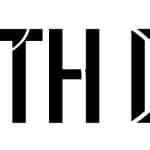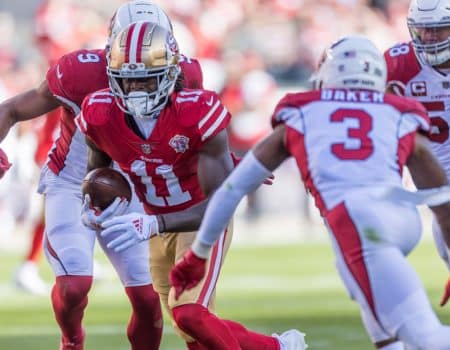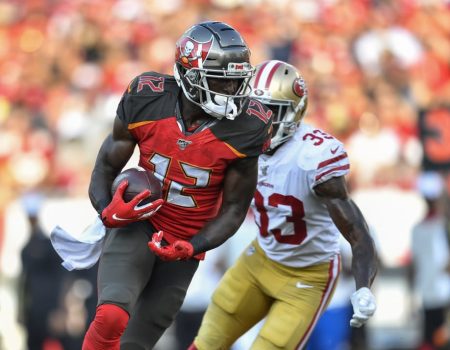Wide Receiver Busts 2018: First, we recapped running backs who have bust potential that is not completely factored into their price. Today, we look at wide receivers who could be the 2018’s version of T.Y. Hilton, Terrelle Pryor or Martavis Bryant.
[2018 Fantasy Football Rankings | Fantasy Football Running Back Busts]
Tyreek Hill – Kansas City Chiefs
Last year, Tyreek Hill became the first player since 2000 to post WR1 numbers in fantasy football despite seeing fewer than 20 percent of his team’s targets and fewer than 10 percent of his team’s red zone targets. All seven of Hill’s touchdowns came from 30 or more yards away, and he scored 3.1 more touchdowns than expected based on his average depth of target and the locations of his targets on the field. Alex Smith had the highest deep passer rating in the NFL — even if all passes to Hill were removed from the sample.
Put simply, the stars aligned perfectly for Hill’s breakout campaign last season, but it’s unlikely that he replicates last year’s efficiency in 2018. For Hill to post similar numbers to last year, he’ll need an increase in volume, and it’s difficult to project Hill for a significant uptick in targets. Kansas City signed Sammy Watkins to a $48 million contract this offseason, a sum that indicates they don’t plan to use him as a decoy. With Watkins, Travis Kelce, and Kareem Hunt in town, Hill will struggle to top the 105 targets he saw last season.
The Chiefs also made Patrick Mahomes their starting quarterback this offseason when they traded Smith to the Redskins. While the move is in Kansas City’s best long-term interest, it hurts all Chiefs skill position players in the short term. Smith was the most efficient deep ball passer in the league last year; with Mahomes at the helm, the splash plays that Hill relies on for fantasy production will occur less frequently. Between impending efficiency regression and the target competition in Kansas City, Hill is an easy fade at his current price.
JuJu Smith-Schuster – Pittsburgh Steelers
JuJu Smith-Schuster was terrific in his rookie season last year, but his efficiency was unsustainable and he is a fade at his current ADP of WR20. Smith-Schuster led the league in fantasy points per target and yards per target en route to a WR23 finish in PPR formats last season.
In Pittsburgh, Smith-Schuster will need to be efficient in order to be fantasy-relevant because he’s the third option in the receiving game behind Antonio Brown and Le’Veon Bell. In general, volume is much more dependable than efficiency for fantasy purposes. 4for4’s TJ Hernandez recently posted an article detailing the most predictable wide receiver stats year-over-year. Volume stats – targets per game, target share – fared much better than efficiency metrics – including yards per target – as a whole. With only 5.6 targets per game and a 16% target share last year, Smith-Schuster will struggle to return value on investment at his current cost.
Assuming his efficiency takes a step back this year, it will be difficult for Smith-Schuster to live up to his WR20 price tag.
Josh Gordon – Cleveland Browns
Per Fantasy Football Calculator, Josh Gordon’s ADP is in the fourth round at WR19. If Gordon hits, he is a league-winner with elite WR1 potential. That makes his cost somewhat understandable. Even though Gordon’s upside is sky high if everything breaks right, he’s too risky to justify his current price.
It’s been five years since Gordon was an elite fantasy wide receiver. Last year, Gordon flashed potential that he could return to his previous self, but only over a five-game sample on a team that attempted the ninth-most pass attempts per game. With Tyrod Taylor in town, the Browns will most likely attempt fewer passes than last season. During his three years as a starter in Buffalo, the most passes Taylor attempted in a season was 436 (for context, the Bears had the fewest team pass attempts in the league last year with 473). While Buffalo’s run-heavy scheme limits quarterback pass attempts, the fact remains that any pass play called in the huddle can transform into a quarterback run given Taylor’s running ability.
Gordon averaged 8.2 targets per game last year, but it’s unlikely that he gets that type of volume this season considering the other pass-catching weapons on the roster. Jarvis Landry, Antonio Callaway, David Njoku and Duke Johnson will provide significant target competition to Gordon. Gordon won’t get enough targets this season to justify his current ADP, and other wideouts around his ADP – such as Amari Cooper and Golden Tate – are better picks due to their projected volume.
Furthermore, Gordon still has not reported to Browns training camp. While the other pass-catchers on the roster are at training camp gaining chemistry with quarterbacks Taylor and Baker Mayfield, Gordon is missing out on valuable reps. At this point, Gordon’s availability for the start of the start of the season is up in the air, but that risk is not baked into his current price. With all the risk factors surrounding Gordon, there are better options in the fourth round of fantasy drafts.
Marvin Jones – Detroit Lions
Marvin Jones finished as a WR1 in fantasy football last season with 1,101 yards and nine touchdowns. While a fifth-round ADP for the previous season’s WR12 would normally be a value, the presence of Kenny Golladay darkens Jones’ outlook.
In the eleven games that Golladay played, Jones averaged 3.1 receptions for 61.3 yards and 0.6 touchdowns. Without Golladay, Jones averaged 5.4 receptions for 85.4 yards and 0.6 touchdowns. On a points per game basis, Jones’ splits with Golladay would have placed him as the WR24. Without Golladay, that number rises to WR5.
Furthermore, Jones is in line for some regression this season. Jones placed 22nd among wideouts in Scott Barrett’s Actual Opportunity stat, a metric that calculates how many fantasy points the average player would score given a player’s opportunity. Of the top 24 wide receivers in Barrett’s stat, only Antonio Brown, Michael Thomas, and Davante Adams outperformed their Actual Opportunity projection by more than Jones. With Golladay healthy and impending regression, Jones makes for a risky proposition in the fifth or sixth round of fantasy drafts.
Will Fuller – Houston Texans
With Deshaun Watson last year, Will Fuller was nothing short of superhuman, averaging 21.0 fantasy points per game in games that Watson played. Despite the excitement surrounding Watson’s return and the rejuvenated Houston offense, Fuller won’t be able to replicate his efficiency from last season. In games that Deshaun Watson started, 53.8 percent of Fuller’s catches went for touchdowns. That rate is unsustainable over the course of a full season, and the Houston offense under Watson in 2018 will not be as prolific as it was for those six games last season. Watson posted the second-highest touchdown rate since 1970 last season, and regression is going to hit him hard this year.
Unlike DeAndre Hopkins, Fuller does not get enough targets to maintain similar fantasy value with a diminished touchdown rate. About 50 percent of Fuller’s fantasy production with Watson starting came from touchdowns, so his value will decrease dramatically if his touchdown rate drops. Wide receiver touchdown rate is one of the least predictive stats on a year-to-year basis, so fade Fuller at his current ADP of WR32.






No Comment! Be the first one.